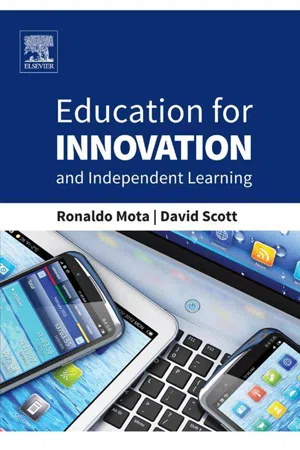![]()
Chapter 1
Introduction
The principal themes of the book are introduced and the productive relationship between innovation, technology and pedagogy is discussed. The introductory chapter, in addition to explaining the argument which runs through the whole book, will also provide an account of the book’s contents.
Keywords
Education; Digital Technologies; Independent Learning; Innovation; Methodology; Sustainability
The future is not something that will happen, the future is what is happening now
(Gary Hamel and C.K. Prahalad, 1994)
Our principal concern in this book is to understand three important ideas: learning, technology and innovation, and to examine these ideas and the relationships between them in situ; that is, we examine a number of cases of learning technologies in action in two countries, England and Brazil. The purpose of our study is to provide an explanation of the means to, and constraints on, improvements to educational policies and practices, with particular reference to innovation. We have a plethora of theoretical models that, in attempting to deal with causal relations, usually come to the conclusion that there are socio-economic-cultural constraints, but these observations largely remain at an abstract level and/or come to very general conclusions that are not of particular help to practitioners in the field. These issues can only be properly addressed after examining the empirical reality and having a spectrum of cases to analyse. By combining the theoretical and the practical, our aim is to explain how and under what conditions new modes of learning can be put into practice successfully and sustainably, in order for the learner to develop innovatory skills and dispositions for work and in his or her life course.
We begin by introducing the principal themes of the book and then argue for a productive relationship between innovation, technology and pedagogy. In addition to explaining the argument which runs through the whole book, this introductory chapter will also provide an account of the book’s contents.
In Chapter 2 we introduce and discuss the central purposes of international education. These are: developing citizens of the world in relation to culture, language and the capacity to live among people of other nations; building and reinforcing a sense of identity and cultural awareness; fostering recognition and development of universal human values; stimulating curiosity and inquiry in order to develop a spirit of discovery and enjoyment of learning; equipping students with the skills to learn and acquire knowledge, individually or collaboratively; and providing an international context for responding to local requirements and interests.
The introduction of an international dimension in educational institutions has important consequences for students, teachers and researchers. It is a phenomenon that is increasingly influencing the way we teach and learn, and thus requires the development of new methodologies. The introduction of technological innovations stricto sensu and innovations lato sensu as key elements for social and economic development is defining the way we rethink the educational process in a world where preparing people for innovation is becoming increasingly important. In the chapter we examine the characteristics of the two educational settings that form the backdrop to this study: Brazil and England.
In Chapter 3 we look at the concept of innovation, a key concept in the formation of modern societies. In the middle ages this meant novelty arising from human creativity; whereas today it has become emblematic of modern societies and directly associated with the possibility of sustainable economic and social development. The concept of innovation is broader than simply technological innovation. More recently, a new wave of innovation approaches such as open innovation, democratizing innovation, creative economies and organizational and marketing innovation have been introduced. Many of these are associated with new types of knowledge production such as workplaces and homes, rather than traditional research laboratories and universities.
In Chapter 4 we examine the importance of innovation in contemporary society and the available new technologies that can be used in education. We suggest that we are entering the third educational revolution, which implies that substantial changes are needed to the traditional ways we use to teach and learn, as well as to how knowledge is produced and disseminated. We are now in a world where it is becoming clearer than ever that, despite the essential roles that traditional education systems have played, standard solutions and approaches are not appropriate for meeting new educational and social needs.
In Chapter 5 we analyse the relationship between education and innovation. This is a complex and rich theme, especially with respect to the impact of new technologies. To better understand the incorporation of digital technologies in the classroom, it is perhaps helpful to remember previous promises and false expectations, as well as the successes and achievements of the older cousins of last century’s “digital technologies”, such as movies, radio and television. It is also worth noting that it is a characteristic of technology-based education in general to place the learner at the centre of the learning process. This allows him or her to have some input into the contents and sequences of the learning process, and thus more independence and greater control over it. We therefore address the complex but important notion of independent learning.
In Chapter 6 we develop a theory of learning, one moreover which takes account of the principal themes of the book: developing new learning technologies, and developing innovatory life-styles. One characteristic of a world where innovation is central is the role played by new technologies, especially digital, including the internet. They have the advantage of allowing the student, as well as the teacher, to develop his or her learning beyond the physical environment of the classroom, thus widening access to education. Even so, we need to be careful about exaggerating the claims made for technological innovations and adopt a more circumspect approach to education and technology. In this case, the term technology refers to far more than just machinery and artifacts—it now also refers to social contexts and circumstances.
In Chapters 7 and 8 we examine a variety of cases of new pedagogic and technological approaches. In Brazil, our cases include: The Digital Educational Project in Piraí-RJ; The C.E.S.A.R. and the Engineering, Education and Entrepreneurship Project; The Veduca Educational Experiment; Start-up Neoprospecta; and the Lemann Center for Education, Entrepreneurship and Innovation. In England, our cases comprise: Teaching Shakespeare at Stratford-upon-Avon; The Extended Project at Rugby School; Team Engineering at the Open University; Work-based Learning at the Institute of Education, University of London; and Think, Play and Do at Imperial College London.
In the final chapter, we bring together the three essential components discussed in the book: pedagogy, technology and innovation, and draw some conclusions about the relationships between them. Education has traditionally contributed to individual learning, the common good and national prosperity. The world is changing and education has to change with it, even if at the moment its approaches, technologies and outputs are outdated, and increasingly unable to cope with the need for innovation in society (see Figure 1.1). This book attempts to make connections between education, technology and innovation in the contemporary world.
Figure 1.1 Medieval copy of a book by Gautier de Metz/1463. “L’image du Monde”. Detail of a miniature of a master and scholars.
![]()
Chapter 2
Educational Settings
The central purposes of international education are introduced and discussed. These are: developing citizens of the world in relation to culture, language and the capacity to live among people of other nations; building and reinforcing a sense of identity and cultural awareness; fostering recognition and development of universal human values; stimulating curiosity and inquiry in order to develop a spirit of discovery and enjoyment of learning; equipping students with the skills to learn and acquire knowledge, individually or collaboratively; and providing an international context for responding to local requirements and interests. The Brazilian and English educational scenarios are presented and analysed.
Keywords
Citizenship; Education in Brazil; Education in England; International Education; Methodology
If we teach today’s students as we taught yesterday’s, we rob them of their future
(John Dewey, 1944)
In this chapter we identify the characteristics of educational environments that allow learning to take place and is directed towards the promotion of sustainable futures. The United Nations Educational, Scientific and Cultural Organization (UNESCO)1 have suggested that these include: (i) a willingness to investigate issues in the local, school, and wider community; (ii) a readiness to recognize social, economic, ecological and political dimensions of issues needed to resolve them; and (iii) the ability to analyse issues and to participate in actions aimed at achieving a sustainable future. A principal concern in citizenship education is the development of these skills for active democratic citizenship roles, and as one of the defining features of a sustainable society2.
The introduction of an international dimension into school and university institutions reaches beyond individual students, teachers and researchers. It emanates from a need to respond to new demands coming from a globalized society that is increasingly moderating the way we teach and learn, and therefore requires new methodologies to be developed. The importance of technological innovations, both stricto sensu and lato sensu, as key elements for social and economic development, is central to a rethinking of educational processes in a world where preparing people for an innovatory culture is considered by some to be of central importance.
2.1 Internationalization
Internationalization in education has, as its primary purpose, the preparation of the academic community, comprising students, teachers and researchers, and those engaged in entrepreneurial activities, for successful participation in an increasingly globalized and interdependent world. Successful international education strategies consist of specific approaches and pedagogies at different levels: institutional, national and sectorial. Why is the development of processes of internationalization and globalization of educational systems and mechanisms considered to be so important? As the world becomes smaller and as nation states become more closely aligned with each other, economic, scientific and technological competitiveness becomes a central element in the global economy.
Technological innovations, especially the emergence of digital technologies and the development of multi-modal forms of expression, are influencing the construction of new educational environments. The growing middle class culture in many countries around the world is creating unprecedented demand for educational services from both private and public suppliers. The number of people entering higher education has increased exponentially over the past decade, with the result that between the years 2000 and 2010 the proportion of adults worldwide who have received tertiary education rose from 19% to 29%, and all reasonable estimates suggest that this trend will continue.
Goddard (2012) estimates that the number of students around the world enrolled in higher education will reach 262 million by 2025, up from 178 million in 2010. In particular, three countries are primarily responsible for the increase in numbers: China (26%), India (18%) and Brazil (14%). Private sector provision for higher education across most of Latin America has increased, with this trend reflected in other parts of the world, particularly in Asia. How these countries will rapidly expand their higher education systems while ensuring that private institutions deliver good quality teaching and learning environments is a key question. One of the consequences of the internationalization process is that opportunities for the educational private sector to expand will grow broader and deeper, because, some have suggested, this sector is able to respond more quickly than the public sector to demand for services and improved travel and communications technologi...

